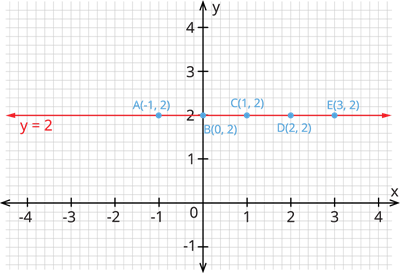UPSKILL MATH PLUS
Learn Mathematics through our AI based learning portal with the support of our Academic Experts!
Learn moreLine parallel to the \(x\) - axis:
Consider drawing a line parallel to the \(x\) - axis. If the distance from the \(x\) - axis and the line is the same, then, the line can be represented as \(y = c\) (where \(c\) is a constant).
Line parallel to the \(y\) - axis:
Consider drawing a line parallel to the \(y\) - axis and the distance between the \(y\) - axis and the line is the same, then, the line can be represented as \(x = c\) (where \(c\) is a constant).
Example:
Draw the graph of \(y = 2\).
Solution:
\(y = 2\) means that whatever be the value of \(x\), the value of \(y\) is \(2\).
Now, let us form the table.
| \(x\) | \(-1\) | \(0\) | \(1\) | \(2\) | \(3\) |
| \(y\) | \(2\) | \(2\) | \(2\) | \(2\) | \(2\) |
Therefore, the points are \((-1,2)\), \((0,2)\), \((1,2)\), \((2,2)\), and \((3,2)\) and name them as \(A\), \(B\), \(C\), \(D\) and \(E\) respectively.
Now, plot these points in the graph and join them.

Now, we get a straight line parallel to \(x\) - axis which is at a distance of \(2\) units from the \(x\) - axis.